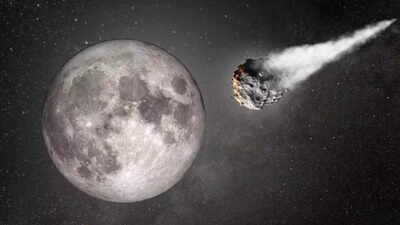NASA issues alarming warning: 'City killer' asteroid could strike Moon in 2032, threatening Earth’s satellites
A potentially catastrophic asteroid, ominously dubbed a “city killer,” is projected to intersect with the Moon's orbit, prompting scientists to warn of potentially hazardous consequences for Earth.

The asteroid, designated 2024 YR4, no longer represents a direct impact threat to our planet. However, NASA estimates a 4.3% probability of it colliding with the lunar surface on December 22, 2032. A collision of this magnitude could eject an estimated 10,000 tonnes of lunar debris into space. Earth’s gravitational field could then pull a significant portion of this debris into orbit, thereby posing a substantial risk to vital satellites and infrastructure.
NASA Simulations Highlight Potential Lunar Impact
Dr. Paul Wiegert, from the University of Western Ontario, conducted simulations indicating that the 60-meter diameter asteroid could strike the Moon at speeds exceeding 29,000 mph. Such an impact is likely to create a crater approximately 0.6 miles in diameter, potentially marking the largest lunar collision in over 5,000 years. The primary concern stems not from the Moon absorbing the direct impact, but rather from the vast amount of debris projected to be expelled into space as a result.
Earth in the Crosshairs
Dr. Wiegert's research team predicts that approximately 10% to 30% of the ejected lunar material, consisting of fragments ranging from 0.1 to 10 millimeters in size, could be drawn towards Earth due to its gravitational influence. Despite their seemingly small size, these high-velocity fragments could inflict considerable damage by disabling satellites. Dr. Wiegert stated to New Scientist, "We were a little bit surprised at the possibility of there being a substantial amount of material at the Earth."
Potential for a Decade's Worth of Satellite Damage in Days
Simulations suggest that this barrage of space shrapnel could elevate particle impact rates by a factor of 10 to 1,000 above normal levels. This surge could potentially trigger satellite failures across numerous orbital paths. Dr. Wiegert cautions that systems such as SpaceX’s Starlink and other satellite constellations could experience “hundreds to thousands” of micro-impacts. The repercussions of such events could include widespread communication outages and GPS malfunctions.
Risks to Lunar Missions and Astronaut Safety
The potential threat isn't confined to Earth. NASA’s projected Lunar Gateway space station and Artemis lunar missions also face potential danger. Rovers, landers, and astronauts operating on or near the Moon could be vulnerable to debris traveling at lethal speeds. Even a 1mm particle could compromise solar cells or puncture spacesuits, while larger fragments, measuring up to 10mm, could penetrate spacecraft exteriors.
Call for Coordinated Space Response
Professor Mark Burchell, from the University of Kent, emphasized the severity of multiple simultaneous satellite failures. He stated that a "lot of satellites failing at once is worse than occasional failures spread over a decade," highlighting the strain that such events would place on resources and emergency response systems. Proactive strategies and shielding technologies may become critical priorities in the coming years.
While the current impact risk is estimated at 4.3%, NASA and other international space agencies are continuing to closely monitor asteroid 2024 YR4. Initial emergency observations conducted by the James Webb Space Telescope helped eliminate the possibility of a direct impact on Earth, but the trajectory towards the Moon will be reassessed as new data becomes available. Experts agree that while the event is far from certain, preparing for its possible effects is of paramount importance.
Newer articles
Older articles
-
 Will Nysa Devgan enter Bollywood like Raveena Tandon's daughter Rasha Thadani? Kajol reveals the truth
Will Nysa Devgan enter Bollywood like Raveena Tandon's daughter Rasha Thadani? Kajol reveals the truth
-
 Mahbub Anam replaces Faruque Ahmed as new BPL chairman
Mahbub Anam replaces Faruque Ahmed as new BPL chairman
-
 This new AI tool can help you book train tickets, get refunds and check details on IRCTC website and app
This new AI tool can help you book train tickets, get refunds and check details on IRCTC website and app
-
 How do graphic designers convert JPG to PDF (Portable Document Format)?
How do graphic designers convert JPG to PDF (Portable Document Format)?
-
 Selena Gomez and Hailey Bieber UNFOLLOW each other amid Justin Bieber drama
Selena Gomez and Hailey Bieber UNFOLLOW each other amid Justin Bieber drama
-
 Suchitra Krishnamoorthi faces backlash for claiming Air India crash survivor was ‘LYING’; Deletes post and issues apology
Suchitra Krishnamoorthi faces backlash for claiming Air India crash survivor was ‘LYING’; Deletes post and issues apology
-
 'Would be remarkable to choose someone else if their last knock was a 170'
'Would be remarkable to choose someone else if their last knock was a 170'
-
 Teen Innovator Soars to New Heights: Mehar Singh Breaks Guinness World Record with Lightning-Fast Drone Ascent
Teen Innovator Soars to New Heights: Mehar Singh Breaks Guinness World Record with Lightning-Fast Drone Ascent
-
 Still swooning over Ahn Hyo Seop and Kim Sejeong in ‘Business Proposal’? Here are 3 new K-Dramas to obsess over next!
Still swooning over Ahn Hyo Seop and Kim Sejeong in ‘Business Proposal’? Here are 3 new K-Dramas to obsess over next!
-
 iQoo Z9 Turbo new leak reveals key specifications: All the details
iQoo Z9 Turbo new leak reveals key specifications: All the details